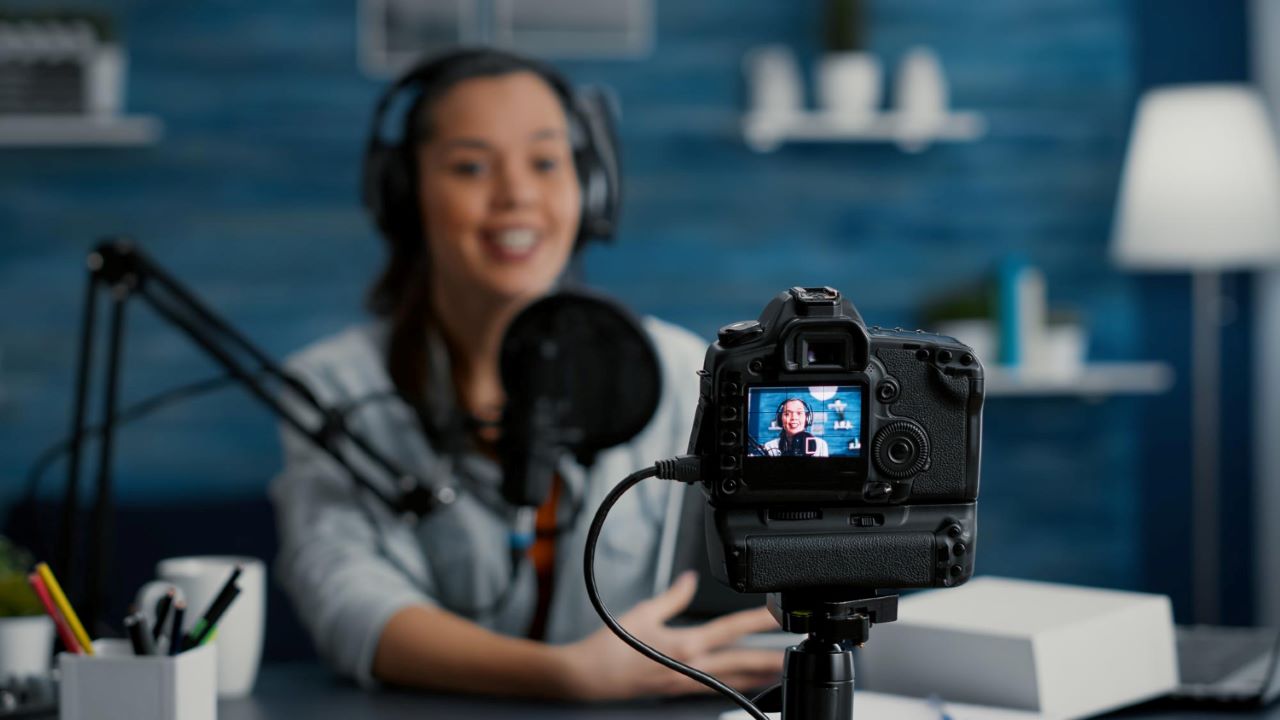Podcasting has exploded in popularity, offering a unique platform for storytelling, sharing knowledge, and connecting with like-minded individuals. Whether you’re a seasoned content creator or a curious newbie, the journey of preparing for a podcast is both exhilarating and daunting.
In this guide, we’ll walk you through how to prepare for a podcast, including the essential steps of conceptualizing, planning, and launching a podcast that not only resonates with your audience but also fulfills your creative aspirations.
From defining your niche to setting tangible goals and crafting your show’s format, we’ve got you covered with practical advice and real-life insights.
Contents
Conceptualizing Your Podcast
Before you hit the record button, it’s crucial to lay a strong foundation for your podcast. This begins with a clear vision of what you want your podcast to be about and whom you want to reach. Let’s delve into the first steps of this exciting journey.
Defining Your Niche And Audience
Identifying your niche is like choosing a destination before you start a journey. It gives your podcast a clear direction and purpose. Start by asking yourself: What are you passionate about? What topics can you talk about for hours without losing interest? Your niche could be anything from mindfulness and mental health to tech trends or culinary adventures.
Understanding your audience is equally important. Who are they? What are their interests, challenges, or pain points? For instance, if your niche is sustainable living, your audience might be environmentally conscious individuals seeking practical tips to reduce their carbon footprint. Remember, a well-defined niche and audience will not only guide your content but also make your podcast relatable and engaging, much like a blog post.
Setting Clear Goals And Objectives
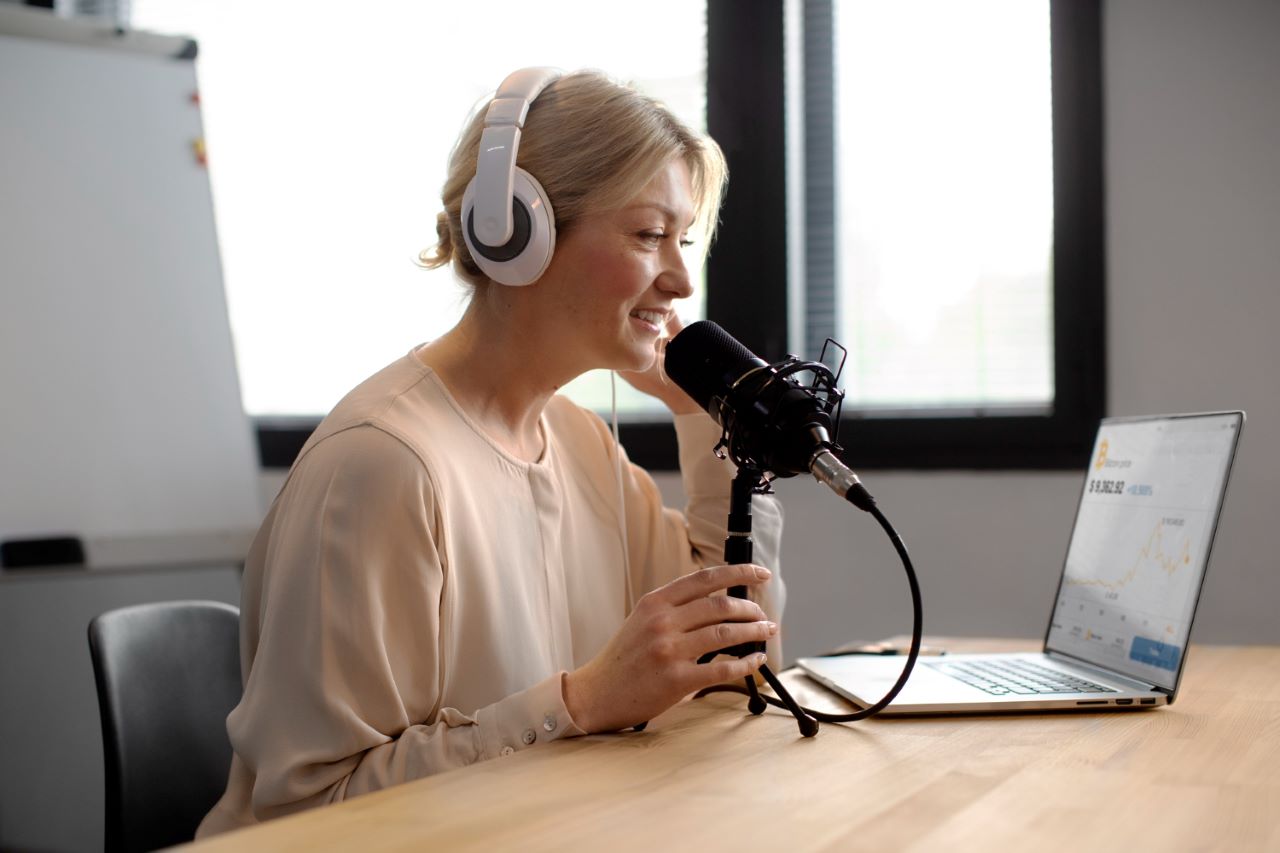
Image by Freepik
Having clear goals and objectives is like having a roadmap for your podcast journey. It helps you stay focused and measure your progress.
Short-term Podcast Goals
- Launch your first podcast episode within a specific timeframe.
- Reach a certain number of downloads or listens for the first few episodes.
- Establish a consistent recording and publishing schedule.
- Build an initial listener base through social media and community engagement.
- Receive listener feedback to refine future content.
Long-term Podcast Goals
- Grow your audience to a specific number over a year.
- Collaborate with other podcasters or guests to expand your reach.
- Monetize your podcast through sponsorships, ads, or merchandise.
- Establish your podcast as a go-to resource in your niche.
- Expand your podcast’s format to include live events or Q&A sessions.
Measurable Objectives for Success
- Track the number of downloads and listener growth month-over-month.
- Monitor listener engagement through comments, emails, and social media interactions.
- Achieve a set number of positive reviews or ratings on podcast platforms.
- Increase website traffic or newsletter sign-ups attributed to the podcast.
- Secure a certain number of sponsorships or partnerships by the end of the year.
Related: Defining Your Podcast Audience
Crafting Your Podcast Theme and Format

Photo by Sebastian Pandelache on Unsplash
Creating a compelling theme and format for your podcast is crucial in defining its identity and appeal. This involves making strategic decisions about how your podcast will be structured, the style of content you’ll produce, and how you’ll engage with your audience. A well-thought-out theme and format not only make your podcast more enjoyable but also help in attracting and retaining listeners who resonate with your style.
Choosing Between Solo, Co-hosted, or Interview Formats
When deciding on the format of your podcast, you have several options, each with its unique dynamics and requirements.
Solo Format
In a solo podcast, you are the sole speaker, sharing your insights, stories, or expertise. This format is deeply personal and allows for a direct connection with your audience. It’s ideal for podcasters who are comfortable speaking at length and have a strong point of view or specialized knowledge.
The challenge here is to keep the content engaging and varied, as the onus of entertainment and information rests solely on you.
Co-hosted Format
This format involves two or more hosts discussing a topic. It’s a great way for podcast producers to bring different perspectives and create a conversational and lively atmosphere. The chemistry between co-hosts is crucial; it should feel natural and engaging to the listener.
Co-hosted podcasts can be easier to produce in terms of content, as the podcast hosts can bounce ideas off each other, but they require good coordination and, often, a consistent recording schedule that suits all hosts.
Interview Format
In this format, you invite guests to discuss topics relevant to your podcast’s theme. This is an excellent way to bring fresh perspectives and expertise to your show. It requires good research and interviewing skills, as you’ll need to ask insightful questions that elicit informative and engaging responses.
Additionally, scheduling and coordinating with podcast guests can be challenging, but this format is highly effective for networking and expanding your audience.
Deciding on Episode Length and Frequency

Image by Freepik
The length and frequency of your episodes are key factors that can significantly impact listener engagement and retention.
Episode Length
The ideal length of your podcast episodes depends on your content and audience preferences. Short episodes, typically 15-30 minutes, are great for focused, concise content and suit listeners who prefer quick, digestible information.
Longer episodes, ranging from 45 minutes to over an hour, are better suited for in-depth exploration of topics, storytelling, or detailed interviews. Consider your subject matter and audience lifestyle when deciding on episode length.
Frequency
How often you release new episodes is another critical decision. A weekly release is standard and helps keep your audience engaged and expecting new content regularly. However, depending on your time constraints and the depth of content you wish to cover, a bi-weekly or monthly schedule might be more manageable.
The key is consistency; choose a frequency that you can maintain over time to build trust and habit with your listeners.
Content Planning And Scripting
Content planning and scripting are the backbone of any successful podcast. This stage involves meticulous research, organization, and creative writing to ensure that each episode is informative, engaging, and aligns with your overall podcast theme. Effective content planning and scripting not only enhance the quality of your podcast but also help in maintaining consistency and delivering value to your audience.
Researching and Gathering Content
The foundation of compelling podcast content is thorough research. This involves delving into your chosen topics, understanding current trends, and gathering accurate information. Utilize a variety of sources like books, academic journals, reputable websites, and interviews with experts to ensure a well-rounded understanding of your subject matter.
Once you have gathered your research, organize it in a way that makes sense for your podcast format. This could involve categorizing information into themes for each episode, creating a series of episodes on a particular topic, or compiling facts and anecdotes that add depth to your narrative.
For podcasts that cover current events or trends, like some popular Apple Podcasts, staying updated with the latest developments is crucial. This might involve regular checks of news sources, subscribing to relevant journals or newsletters, and engaging with online communities related to your niche.
Writing a Compelling Script or Outline
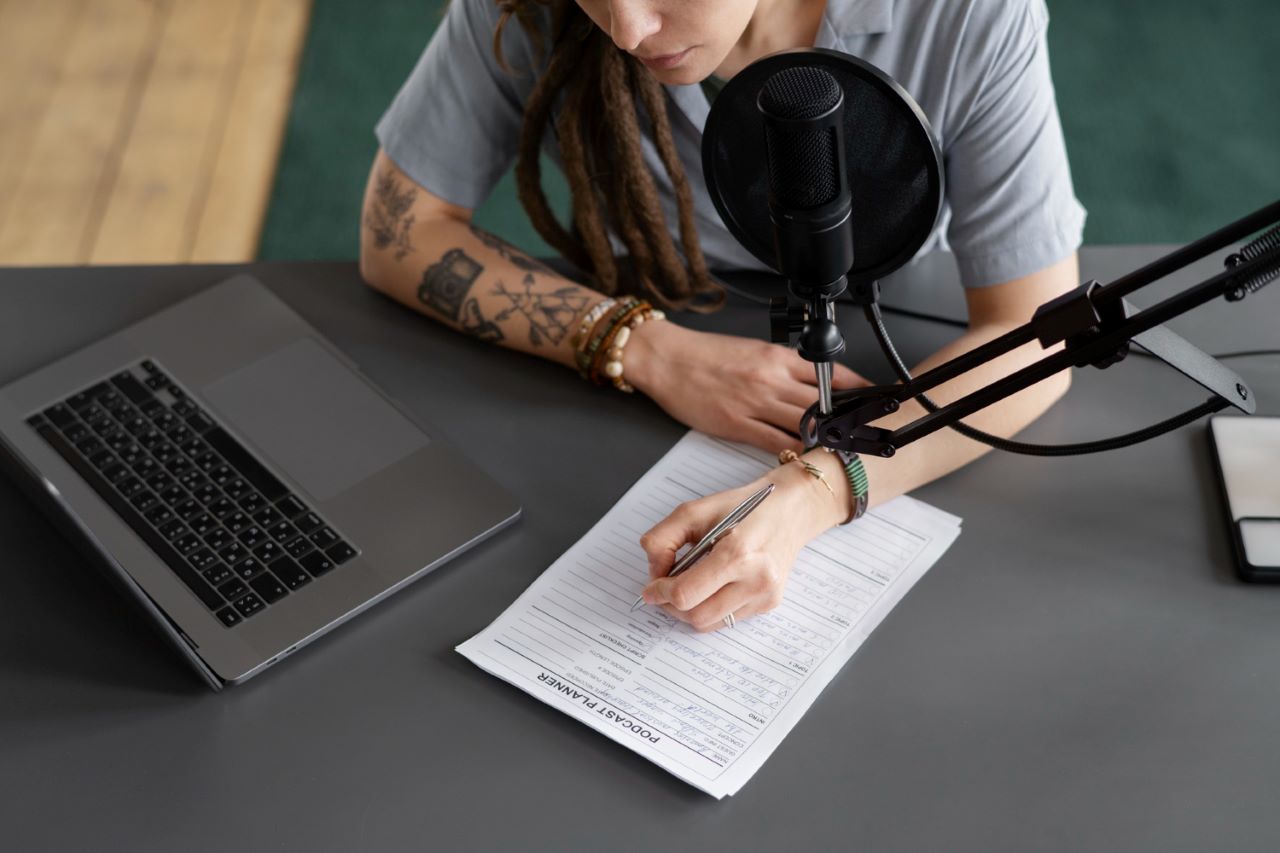
Image by Freepik
Decide whether you need a full script or an outline. A script is a word-for-word transcription of what you will say, ideal for ensuring precision and consistency, especially in solo formats. An outline, on the other hand, provides a structured guide for your episode, allowing more spontaneity and natural flow, which is often preferred in co-hosted or podcast interview formats.
Whether scripting or outlining, include key elements such as an engaging introduction, clear transitions between topics, and a strong conclusion. Don’t forget to weave in calls to action, like encouraging listeners to subscribe or follow your social media channels.
Regardless of the topic, find ways to make your content engaging. This can involve storytelling, presenting intriguing questions, or relating topics to real-life scenarios. The goal is to keep the listener interested and invested in the podcast episode.
Guest Management
Managing guests is a critical aspect of podcasting, especially for formats that rely on interviews or guest appearances. This involves identifying potential guests, effectively inviting them, preparing for the interviews, and ensuring a smooth technical setup, especially for remote guests.
Proper podcast guest management not only enhances the quality of your episodes but also builds your network and reputation as a podcast host. Additionally, learning from other podcasts can provide valuable insights into effective guest management strategies.
Identifying And Inviting Guests
When it comes to enriching your podcast with diverse voices and expertise, the process of identifying and inviting guests plays a pivotal role. The key is to pinpoint individuals who not only align with your podcast’s theme but also bring unique perspectives and value to your audience.
Start by creating a list of potential guests – these could be thought leaders, industry experts, influencers, or even individuals with compelling stories relevant to your niche. Research each potential guest thoroughly, understanding their background, recent work, and how their expertise or experiences can contribute to your podcast’s objectives.
Crafting a personalized invitation is crucial. Reach out with a well-thought-out message that highlights why you believe they would be a perfect fit for your podcast. Explain the nature of your podcast, the kind of topics you cover, and how their participation could benefit both them and your audience. Be specific about what you admire in their work or expertise, as this shows genuine interest and preparation. Remember, a personalized approach can make a significant difference in their response.
Once you’ve sent out the invitation, patience and persistence are key. If you don’t hear back within a reasonable timeframe, a polite follow-up is appropriate. Upon receiving a positive response, promptly send a confirmation along with all the necessary details like the proposed recording date, time, and any preparatory material they might need. This level of professionalism sets the tone for a successful collaboration.
Preparing For Guest Interviews

Image by Freepik
Preparing for guest interviews is a meticulous process that demands thorough research and thoughtful planning. Start by diving deep into your guest’s background, recent works, achievements, and any previous interviews they’ve done. This research will not only help you formulate insightful questions but also assist you in steering the conversation in a direction that’s both engaging for your audience and respectful of your guest’s expertise.
Communication with your guest prior to the interview is crucial. Share with them the format of your podcast, the general flow of the interview, and the type of questions you plan to ask. This helps in aligning expectations and ensures your guest feels comfortable and prepared.
While it’s important to have a set of prepared questions, flexibility is key. Be ready to explore interesting tangents or follow-up questions that arise naturally during the conversation. This approach keeps the interview dynamic and engaging.
Additionally, it’s beneficial to discuss any specific topics or areas your guest is particularly keen to explore or, conversely, any topics they prefer to avoid. Such open communication fosters a trusting relationship and contributes to a more authentic and smooth-flowing interview.
Technical Setup For Remote Guests
Ensuring a seamless technical setup for remote guests is essential for producing a high-quality podcast. The first step is selecting the right tools and platforms for recording the interview. Options like Zoom, Skype, or specialized podcast recording software offer various features that can cater to different needs. It’s important to choose a platform that is not only reliable but also user-friendly for your guests.
Prior to the interview, conduct a technical run-through with your guest to test the audio quality and troubleshoot any potential issues. Advise them on using a high-quality microphone if available, and suggest ways to minimize background noise and echo. This might include recording in a quiet room, using headphones, and turning off any unnecessary devices that might cause interference.
Additionally, discuss and set up a backup recording method. This could be as simple as having a secondary recording device or using a software feature that automatically records the call. Having a backup ensures that you don’t lose valuable content due to unforeseen technical glitches.
Finally, provide clear instructions and support to your guest throughout this process. Remember, not all guests may be tech-savvy, and offering guidance can greatly enhance their comfort level and the overall quality of the recording. By taking these steps, you ensure a smooth and professional experience for both your guest and your audience.
Rehearsal And Pre-Recording Preparation
Rehearsal and pre-recording preparation are critical steps in the podcast production process. They ensure that both the technical and creative aspects of your podcast are finely tuned before hitting the record button. This phase involves testing and adjusting your equipment, refining your content, and preparing yourself both mentally and physically.
Effective preparation not only enhances the quality of your podcast but also boosts your confidence as a host, leading to a more engaging and professional recording.
Conducting Rehearsals
Rehearsals are essential for a smooth recording session. They help you familiarize yourself with your content, fine-tune your delivery, and identify any potential issues with your script or flow. During rehearsals, practice your entire episode as if you were recording live. This includes running through your script or outline, interacting with co-hosts or guests if applicable, and even pausing for hypothetical ad breaks.
Pay attention to the pacing, clarity, and energy of your delivery. Rehearsals are also the perfect time to experiment with different intonations or approaches to your content, finding the best way to convey your message to your audience.
Testing Technical Equipment
Testing your technical equipment is crucial to avoid any unforeseen issues during the actual recording.
- Microphone: Check your microphone for clarity and the absence of static or background noise. Experiment with different positions to find the best sound quality.
- Headphones: Ensure your headphones are comfortable and provide clear audio without any distortion.
- Recording Software: Familiarize yourself with your recording software. Check that it’s recording at the correct levels and that you know how to operate essential functions like start, stop, and pause.
- Internet Connection (for Remote Interviews): If you’re conducting remote interviews, test your internet connection for stability and speed to avoid any disruptions during the call of your great podcast interview.
Practicing Delivery and Timing
Practicing your delivery and timing is about more than just getting through your script or outline. It’s about ensuring that your podcast has a natural flow and rhythm. Pay attention to your speech rate – are you speaking too fast or too slow?
Practice articulating your words clearly and with the right emphasis. Timing is also crucial, especially if your podcast has a strict time limit. Use a timer during rehearsals to gauge the length of your segments and adjust accordingly.
Finalizing Content And Flow
Finalizing your content and flow involves reviewing and refining your script or outline to ensure it aligns with your podcast’s goals and engages your audience effectively.
Reviewing and Adjusting the Script/Outline
Go through your script or outline with a critical eye. Look for areas that can be improved for clarity, engagement, and flow. Ensure that your content is logically structured and that transitions between topics or segments are smooth. This is also the time to cut out any unnecessary fluff that doesn’t add value to your podcast.
Confirming Guest Preparedness
If your episode includes guests, confirm their preparedness before recording. This includes ensuring they have received and understood the outline or key points of discussion, are comfortable with the technology being used, and are aware of the recording schedule. A pre-recording check-in can help alleviate any last-minute jitters or confusion.
Mental And Physical Preparation
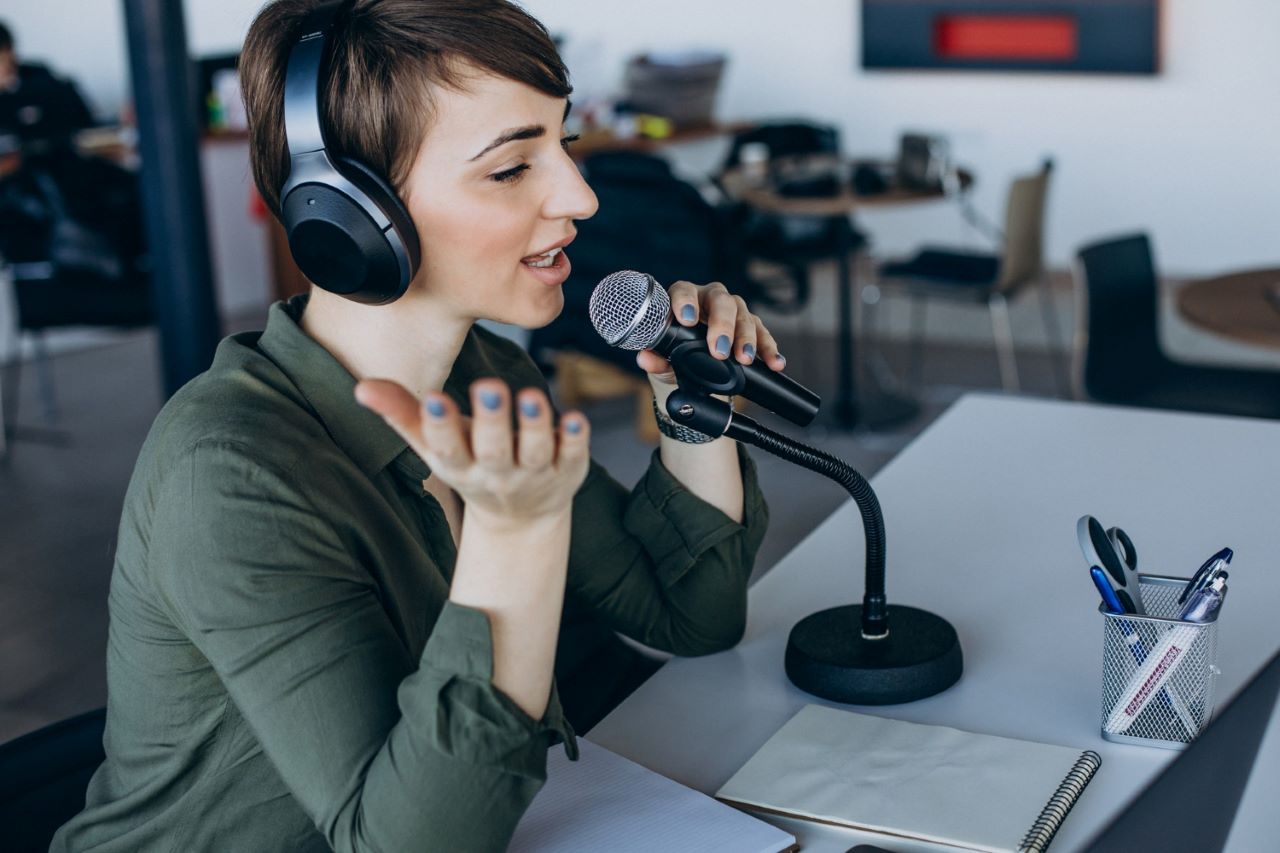
Image by senivpetro on Freepik
Preparing yourself mentally and physically is just as important as preparing your content and equipment.
Techniques for Relaxation and Focus
- Deep Breathing: Practice deep breathing exercises to calm nerves and increase focus. Inhale slowly for a count of five, hold for a count of five and exhale for a count of five.
- Mindfulness Meditation: Spend a few minutes in mindfulness meditation, focusing on your breath or a particular object to clear your mind and reduce anxiety.
- Visualization: Visualize a successful recording session. Imagine speaking confidently and your audience engaging positively with your content.
Vocal Warm-ups and Exercises
- Lip Trills: Gently vibrate your lips together while making a sound. This helps relax your lips, jaw, and facial muscles.
- Tongue Twisters: Practice tongue twisters to improve articulation. This can be particularly useful for warming up your mouth and preventing stumbling over words.
- Humming: Hum at different pitches to warm up your vocal cords. Start at a comfortable pitch and then move up and down your vocal range.
Each step is designed to ensure that you are fully prepared for a successful and professional podcast recording.
How To Prepare For A Podcast: Technical Setup
The technical setup is a fundamental aspect of podcast preparation, directly impacting the quality and professionalism of your final product. This stage involves selecting the right equipment, setting up an optimal recording environment, and understanding how to manage audio quality effectively.
A well-thought-out technical setup not only ensures that your podcast sounds crisp and clear but also makes the recording process smoother and more efficient.
Choosing The Right Equipment
Selecting the right equipment is crucial for producing a high-quality podcast. This includes choosing the best microphones, headphones, recording devices, and software that suit your specific needs and budget.
Microphones
The microphone is arguably the most important piece of equipment for a podcaster.
- Dynamic Microphones: Ideal for recording in less-than-perfect acoustic environments, dynamic microphones are less sensitive to background noise and are great for capturing clear vocal tones.
- Condenser Microphones: These are more sensitive and provide a higher-quality audio recording, making them suitable for controlled studio environments. They capture a wider range of frequencies and nuances in the voice.
- USB vs. XLR Microphones: USB microphones are convenient and easy to use, perfect for beginners or those with a simple setup. XLR microphones, on the other hand, require an audio interface but offer better sound quality and are more scalable for advanced setups.
Headphones
Quality headphones are essential for monitoring your audio during recording and editing.
- Closed-Back Headphones: These are recommended for recording as they prevent sound leakage that could be picked up by the microphone.
- Comfort and Clarity: Choose headphones that are comfortable to wear for long periods and provide clear, accurate sound reproduction. This helps in identifying and correcting any issues in the audio during recording and editing.
Recording Devices
While many podcasters start with their computer’s built-in recording capabilities, dedicated recording devices can offer enhanced control and quality.
- Portable Digital Recorders: These are excellent for on-the-go recordings, interviews in the field, and as a backup recording system.
- Audio Interfaces: For a more professional setup, an audio interface can provide superior sound quality and more input/output options.
Software for Recording and Editing
Choosing the right software is crucial for recording and editing your podcast.
- Recording Software: Options like Audacity (free) and Adobe Audition (paid) offer different levels of complexity and features. Consider ease of use, compatibility with your equipment, and the specific functions you need.
- Editing Software: Good editing software allows you to cut, splice, add effects, and adjust levels to produce a polished final product. Some software offers both recording and editing capabilities, which can be convenient.
Setting Up Your Recording Environment
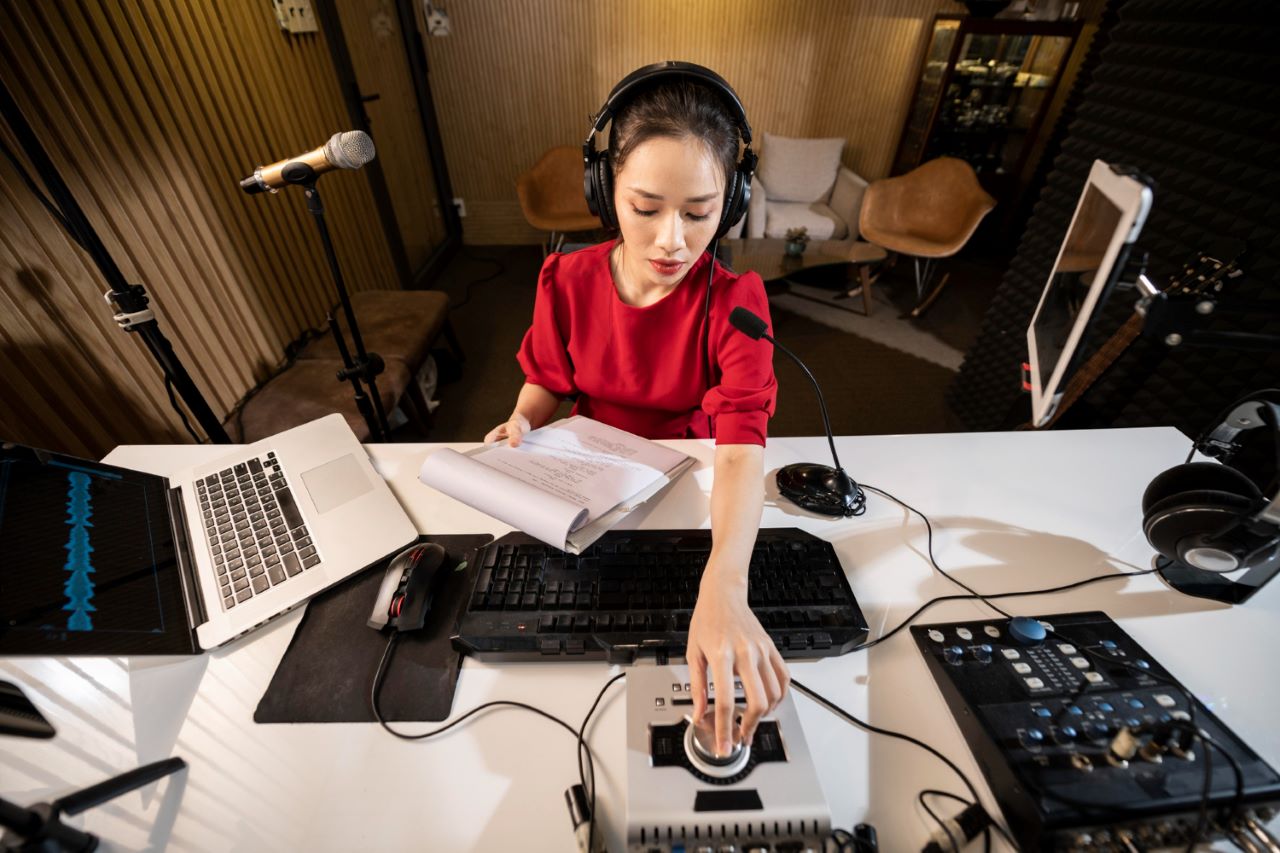
Image by Freepik
Your recording environment plays a significant role in the quality of your audio.
- Room Acoustics: Choose a quiet room with minimal echo. Soft furnishings, carpets, and curtains can help absorb sound and reduce echo.
- Microphone Placement: Position your microphone correctly to avoid plosives and minimize breathing sounds. A pop filter can be a useful addition.
- Minimizing Background Noise: Ensure the recording environment is as quiet as possible. Turn off fans, air conditioners, and mute phones to avoid interruptions.
Understanding And Managing Audio Quality
Managing audio quality is about more than just having the right equipment; it’s about understanding how to use it effectively.
Tips for Clear and Crisp Audio Production
- Proper Mic Technique: Speak at a consistent distance and angle from the microphone to maintain consistent audio levels.
- Use of Pop Filters: Pop filters help in reducing plosives (hard ‘P’ and ‘B’ sounds) that can cause spikes in your audio.
- Gain Control: Adjust the gain on your microphone or interface to ensure you’re recording at optimal levels – not too quiet, but without peaking and causing distortion.
- Room Treatment: Consider using acoustic panels or foam to treat your room, especially if you’re dealing with echo or reverb issues.
- Regular Monitoring: Use headphones to monitor your audio in real-time, allowing you to catch and correct issues as they occur.
Wrapping Up
Embarking on the journey of podcast preparation is an exciting venture that blends creativity with technical skill. From conceptualizing your podcast’s theme to choosing the right equipment and setting up your recording environment, each step is integral to crafting a podcast that resonates with your audience.
Remember, defining your niche and audience sets the foundation, while clear goals and a well-thought-out format give your podcast direction and appeal. Content planning, scripting, and guest management are key to creating engaging and valuable episodes.
Rehearsals, along with technical and environmental setups, ensure that your podcast not only sounds professional but also captures the essence of your message. Understanding and managing audio quality further elevates the listener’s experience. Throughout this process, remember that consistency, authenticity, and passion are your best tools.
Whether you’re a seasoned podcaster or just starting out, these guidelines will help you navigate the podcasting landscape, allowing you to create content that informs, entertains, and inspires.
